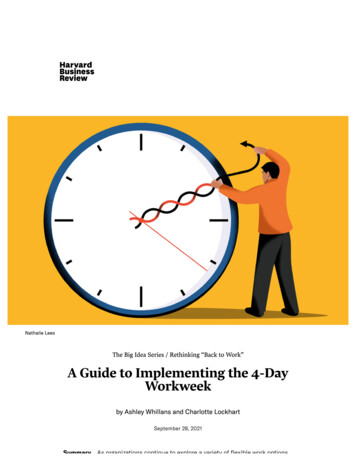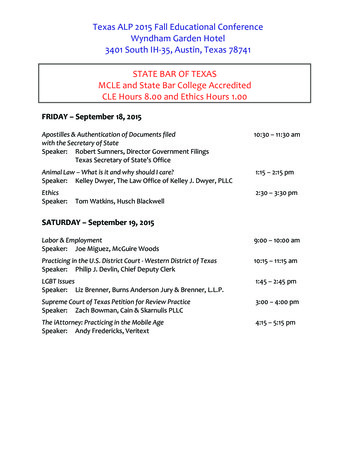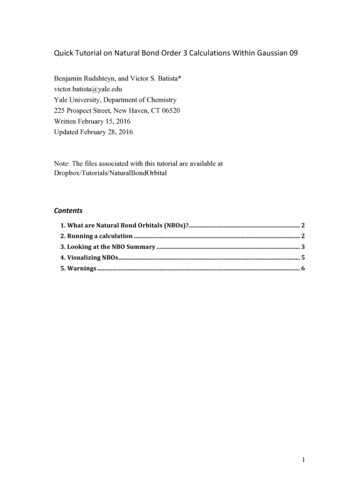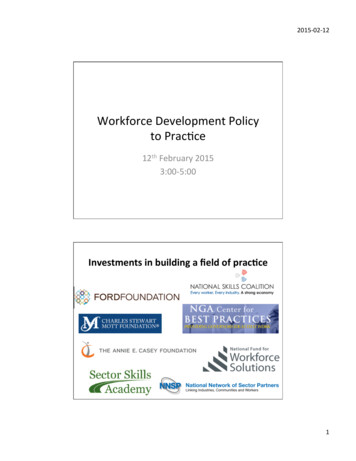
Transcription
Nathalie LeesThe Big Idea Series / Rethinking “Back to Work”A Guide to Implementing the 4-DayWorkweekby Ashley Whillans and Charlotte LockhartSeptember 28, 2021Summary As organizations continue to explore a variety of flexible work options
Summary. As organizations continue to explore a variety of flexible work options,one promising avenue is the four-day workweek: The standard 40 hours per weekis reduced to 32 hours, with the same pay and the same productivity expectations.Research suggests. moreIn June of this year, Kickstarter became the latest in a string oforganizations to announce they are experimenting with a fourday workweek. Its employees will be working 32 rather than 40hours per week, while being expected to achieve the sameproductivity levels and earning the same pay. Though somerecent studies on the efficacy of the four-day week have beenoverblown in the media, research suggests that reducing workhours can decrease employee stress and improve well-beingwithout impacting productivity — but only when implementedeffectively.So, what does that look like? One of us (Ashley) is an academicresearcher focused on time, money, and happiness, and the other(Charlotte) is CEO of a global nonprofit that funds research onfour-day workweek practices and the future of work. We’vecreated a six-step guide to help organizations plan and roll out areduction in working hours. While our focus in this piece is onoffice-centric knowledge jobs, we believe our recommendationscan apply to any company where adjusting work hours is possible.[ Step 1 ]Shift Your MindsetPsychological research suggests that most of us are “mediummaximizers” — we tend to focus on objective, easily quantifiablesuccess metrics such as hours worked, rather than morequalitative metrics such as productivity or well-being. As a result,many companies use immediate responsiveness and time at theoffice as proxies for employees’ commitment levels, even whenthose measures seldom correspond to actual value added to theorganization.For a four-day workweek to be successful, leaders must shift theirmindsets to value actual productivity, not just hours worked.They must ensure that employees aren’t worried they will be
penalized for prioritizing work-life balance, and that starts withmodeling a healthier work-life balance themselves. Ashley’sresearch has found that explicitly framing a reduced-workinitiative as a companywide policy rather than an informal oroptional project can go a long way in encouraging this criticalmindset shift.In addition, leaders must embrace the uncertainty that comeswith trying out a new initiative. The first mistake we’ve seenmany managers make is attempting to anticipate all possibleproblems and eliminate all possible sources of risk before the piloteven begins. While planning is important, falling into decisioninertia helps no one — and real problem solving is only possiblethrough trial and error, not in closed-door conversations amongleadership.This also means accepting that some people won’t like thechanges and some might even quit as a result. That’s OK.Managers should openly acknowledge that the new plan mightnot work for everyone. Remember: When one employee leaves, itcreates room for others who buy into the new culture, ultimatelystrengthening the team and the business.[ Step 2 ]Define Your Goals and MetricsOnce you’ve decided that your organization is ready to make achange, it’s time to start planning. Both employees and leadersshould be actively involved in a number of critical decisions. Onecompany Charlotte and her team worked with formed anemployee-driven subcommittee to spearhead the rollout of itsreduced-hours program. The small working group (lovinglynicknamed the “pessimist committee”) met for an hour each dayfor six weeks to discuss potential problems before launching thepilot.Based on this and other case studies, here are some questions thatwe’ve found can be helpful to consider:
Questions for employees:Should we work four eight-hour days, or reduced hours on fivedays?Which days or hours should we take off?How can we keep the change from negatively impacting ourclients, customers, and other stakeholders?What steps can we take to increase our productivity?How will we share our ideas for process improvements with oneanother?Questions for leadership:How will the organization measure productivity?What support will employees need to make this pilot a success?How long should the organization run this pilot?Are there any legal concerns we should be aware of?As a part of these conversations, it will be critical to consider howyou will measure the success of the program in relation to thegoals you identify. That includes outcomes you hope will change,such as employee happiness, as well as outcomes you hope won’tchange, such as client satisfaction and productivity.[ Step 3 ]Communicate Internally and ExternallyNext, think through your communication plan. There are anumber of concerns that are likely on the minds of internal andexternal stakeholders, and it’s important for leaders to beproactive in addressing them.Internally, the biggest questions will probably be around how thechange will affect people’s jobs. Be clear about your reasons fortrying out the four-day workweek, and assure your employees
that they will not be laid off, experience a pay cut, or lose out onother benefits like paid vacation.In addition, it’s likely that reducing work hours will necessitatechanges to some internal processes and norms, so it’s importantto discuss that up front. For example, at one organization weworked with, employees introduced weekly 30-minute meetingsto cover everything that had previously been discussed in lessefficient, ad hoc meetings, which reduced interruptions and thusincreased “heads-down” work time. In fact, Ashley’s recentresearch found that the pandemic made some knowledge workersmore efficient, in part because it forced them to be moredeliberate in scheduling collaboration time.Every organization is different, so encourage conversations abouthow to get more done in less time — whether that’s byimplementing new tools, eliminating unnecessary meetings, ormaking existing meetings more effective.The same is true externally. Many companies worry what theirclients will think if they reduce hours, but those worries can oftenbe assuaged with a simple conversation. Identify whichcustomers, partners, or other stakeholders might be affected, andwork with the appropriate internal representatives to ensure thescheduling change is communicated clearly.In many cases, you’ll be surprised by how receptive the externalparty is. During one of Ashley’s studies, employees engaged in atime-blocking experiment that made them unavailable toeveryone, including their clients, for hours or even full days at atime. Despite managers’ fears, both the employees and theirclients reported higher levels of satisfaction than before the shift.[ Step 4 ]Run a Pilot
You’ve decided, you’ve planned, you’ve communicated — it’s timeto act! Remember that in the pilot stage, the goal isn’t to geteverything right from the start, but rather to identify the tools andprocesses your organization needs to make reduced work hourspossible. You will likely need at least a few months to implement afull-scale pilot study. During this time, problems will arise. Tryyour best to address them as they happen, knowing that full-scalesolutions might have to wait until the pilot is over. View anyissues not as indicators of failure, but as opportunities to improveand fine-tune your implementation plan. Some questions we’veseen come out of pilot programs include:What are the boundaries I need to put in place for myself andmy team?What assistance do I need from leadership to accomplish areduced work schedule?What will happen to team activities like “cake Fridays”?Creating an environment in which people feel safe asking thesequestions — yes, even about your workplace dessert rituals — isan essential ingredient for a successful pilot. Trust that youremployees are doing their best to make good decisions, andsupport them as they try out different methods to increase theireffectiveness.[ Step 5 ]Assess the PilotOnce the pilot is complete, there are a number of ways you cananalyze the results. First, there are both qualitative andquantitative metrics that can help you understand how the pilotimpacted employee well-being. Qualitatively, group interviewscan provide insight into employees’ experiences with the four-dayworkweek, and more-formalized job satisfaction surveys canidentify trends and changes in self-reported levels of stress, work-
life balance, and quality of life. Quantitatively, there are othermetrics you can look at. For example, did employees take fewersick days during the pilot? If so, this might suggest that employeesfelt less burned out.As far as productivity, the relevant metrics will depend on theteam. On sales teams, it might make sense to focus on the numberof deals created, conversion rates, or average closing times. Oncreative teams, you can monitor subjective areas of performance,such as the quality of internal and external content, byconducting 360-degree reviews or collecting data on the numberof click-throughs for online posts.Watch HBR editor Ramsey Khabbaz’s conversation withAshley Whillans on the 4-day workweek:harvard business review2.5M followersView Profile
View More on Instagram1,262 likesAdd a comment.Data can also help you understand how employees are optimizingtheir work: Are they working more overtime, cutting meetings,taking fewer breaks, working faster? You don’t want peoplesacrificing breaks, rushing their work, or being on the clocklonger, so if you see evidence of these behaviors, you might needto have conversations about reducing individual workloads orfinding ways to make the work itself more efficient.Most importantly, there is no need to reinvent the analysis wheel.While the specifics will be unique to your organization, there arenumerous white papers, reports, and case studies you can look tofor inspiration when making sense of your results. It can also bebeneficial to partner with an academic or other specialist who canhelp you identify the most useful metrics and crunch thenumbers.
[ Step 6 ]Scale Up — but Don’t Stop IteratingAfter you’ve evaluated the pilot and addressed any issues thatemerged, take steps to make the schedule change permanent.Leaders will need to work across the organization to embed newpractices into their workplace culture, ensure that people don’tslip into old habits (no emailing on days off!), and remain focusedon productivity — not hours worked — as the metric of success.At the same time, it’s critical to track success metrics over thelong term and to adapt your processes according to what theyshow. One effective strategy is to maintain employee-led workingsessions and focus groups even after the initial pilot results areanalyzed, to help identify and overcome ongoing challenges. Forexample, after rolling out a four-day workweek, one companyCharlotte worked with discovered that employees were sufferingfrom a challenge known as the mere urgency effect: They becameoverly focused on urgent but less important tasks at the cost oflong-term, more important ones. Based on this insight, thecompany scheduled monthly meetings to discuss long-termstrategic plans, helping to keep priorities aligned.The company also found that existing incentive structures werenot as effective with the new working schedule. Specifically, salesteams, which were rewarded based on the number of deals closed,began prioritizing smaller accounts in order to close more deals inless time, rather than focusing on larger, strategically importantaccounts. As a result, the company reorganized the sales teamsinto dedicated small and large account specialists to ensure thatequal resources would be spent on both areas of the business.Of course, it’s not just about productivity. Another companyCharlotte worked with found that employees had begun working
10-hour days to fit work into a four-day week, significantlyimpacting job satisfaction and well-being. To address this, theleadership team restructured some divisions to make sureemployees were focused on the right tasks, created new positionsto focus on tasks outside the scope of existing teams, and usedtemporary contracts to ease the burden on full-time employeesduring rush periods.Every organization will uncover its own challenges when it comesto scaling up a reduced work hours policy. Constantexperimentation and iteration will be essential to any successfullong-term rollout.Workplace norms have fundamentally shifted over the last yearand a half. Today we find ourselves in a liminal period: We nowhave the chance to remake our models of work before things goback to the way they were — and that’s an opportunity leadersmust not squander. While no change comes easily, leaders willingto embrace models like the four-day workweek will find theexperimentation well worth the effort.Ashley Whillans is an assistant professor in thenegotiations, organizations, and markets unit atthe Harvard Business School School and teachesthe “Negotiations” and “Motivation andIncentives” courses to MBA students andexecutives. Her research focuses on the role ofnoncash rewards on engagement and the linksbetween time, money, and happiness. She is theauthor of Time Smart: How to Reclaim Your Time& Live a Happier Life (Harvard Business Review,2020).CL
Charlotte Lockhart is a business advocate,investor, and philanthropist with more than 25years of experience in multiple industries bothlocally and overseas. As CEO for the 4 Day WeekGlobal campaign, she promotes the benefits of aproductivity-focused and reduced-hourworkplace. She is on the board of the WellbeingResearch Centre at Oxford University and theadvisory boards of the U.S. campaign and theIreland campaign for the four-day week.
k_ Xkk_ \pn cce fkY\cX [ f]]#\og \i \e Z\Xg XpZl k#ficfj\fl kfe. fk_ \iY\e \] kjc b\g X [ mXZXk fe % @e X[ [ k fe # kÈjc b\cpk_ Xki\[ l Z e n fib_ fl ijn cce \Z\jj kXk\











